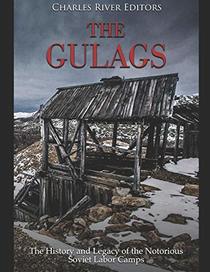Helpful Score: 1
The shocking thing I learned was that the Romanov's started the gulags -- but Stalin turned them into death camps (at their apex, they held 2.5 million). Siberia is such a cold and isolated place (66% of the country but with only 40 million persons therein), that is is probably not surprising that political prisoners were sent there for forced labor and concentration camps (indoctrination). The climate was punishment enough, but the inmates were subjected to slave labor besides.
Mostly, we have learned of the Gulags from author Aleksandr Solzhenitsyn and a few studies completed after the fall of communism. Prisoners were used in completing large infrastructure projects (for example the White Sea-Baltic Canal, the Moscow-Volga Canal, and the Kolyma Highway). The photos offered in this book were plentiful and provided a look at the main characters in this program in the USSR. One fact that was shocking -- 25% of the people in the gulags were Ukrainians).
It was interesting to learn that the gulags were used as an international issue during the Cold War; when human rights became a foreign policy priority in the West. Another surprising fact is that Joseph Stalin was imprisoned in the early camps and escaped twice (they were called Katorga under the Romanovs and changed to the Gulags under the Bolsheviks).
Overall, this is a fascinating look into the KGB, the Lubyanka Building in Moscow, and the persecution (and deaths) of millions of Russians. I thought the explanation of the different leaders of the USSR was very interesting; particularly how each man was different in his approach. Before reading this, I was not sure of the relationship between Trotsky, Lenin, and Stalin.
Mostly, we have learned of the Gulags from author Aleksandr Solzhenitsyn and a few studies completed after the fall of communism. Prisoners were used in completing large infrastructure projects (for example the White Sea-Baltic Canal, the Moscow-Volga Canal, and the Kolyma Highway). The photos offered in this book were plentiful and provided a look at the main characters in this program in the USSR. One fact that was shocking -- 25% of the people in the gulags were Ukrainians).
It was interesting to learn that the gulags were used as an international issue during the Cold War; when human rights became a foreign policy priority in the West. Another surprising fact is that Joseph Stalin was imprisoned in the early camps and escaped twice (they were called Katorga under the Romanovs and changed to the Gulags under the Bolsheviks).
Overall, this is a fascinating look into the KGB, the Lubyanka Building in Moscow, and the persecution (and deaths) of millions of Russians. I thought the explanation of the different leaders of the USSR was very interesting; particularly how each man was different in his approach. Before reading this, I was not sure of the relationship between Trotsky, Lenin, and Stalin.




